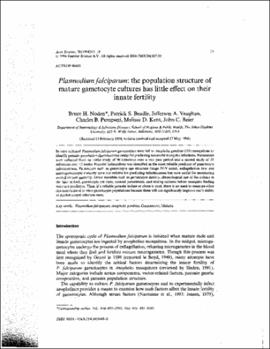| dc.contributor.author | Noden, Bruce H. | |
| dc.contributor.author | Beadle, Patrick S. | |
| dc.contributor.author | Vaughan, Jefferson A. | |
| dc.contributor.author | Pumpuni, Charles B. | |
| dc.contributor.author | Kent, Melissa D. | |
| dc.contributor.author | Beier, John C. | |
| dc.date.accessioned | 2022-04-12T13:44:44Z | |
| dc.date.available | 2022-04-12T13:44:44Z | |
| dc.date.issued | 1994 | |
| dc.identifier | oksd_noden_plasmodiumfalciparum_1994 | |
| dc.identifier.citation | Noden, B. H., Beadle, P. S., Vaughan, J. A., Pumpuni, C. B., Kent, M. D., & Beier, J. C. (1994). Plasmodium falciparum: The population structure of mature gametocyte cultures has little effect on their innate fertility. Acta Tropica, 58(1), pp. 13-19. https://doi.org/10.1016/0001-706X(94)90117-1 | |
| dc.identifier.uri | https://hdl.handle.net/11244/335144 | |
| dc.description.abstract | In vitro cultured Plasmodium falciparum gametocytes were fed to Anopheles gambiae (G3) mosquitoes to identify parasite population characteristics useful for predicting successful mosquito infections. Parameters were collected from an initial study of 90 infections over a two year period and a second study of 55 infections over 12 weeks. Parasite isolate/clone was identified as the most reliable predictor of gametocyte infectiousness. Parameters such as gametocyte age structure (stage IV:V ratio), exflagellation rate and macrogametocyte maturity were not reliable for predicting infectiousness but were useful for monitoring overall culture maturity. Other variables such as gametocyte density, chronological age of the culture at the time of feed, gametocyte sex ratio, asexual parasitemia, and mixing cultures before mosquito feeding were not predictive. Thus, if a reliable parasite isolate or clone is used, there is no need to measure other characteristics of in vitro gametocyte populations because these will not significantly improve one's ability to predict oocyst infection rates. | |
| dc.format | application/pdf | |
| dc.language | en_US | |
| dc.publisher | Elsevier BV | |
| dc.relation.ispartof | Acta Tropica, 58 (1) | |
| dc.relation.uri | https://www.ncbi.nlm.nih.gov/pubmed/7863850 | |
| dc.rights | This material has been previously published. In the Oklahoma State University Library's institutional repository this version is made available through the open access principles and the terms of agreement/consent between the author(s) and the publisher. The permission policy on the use, reproduction or distribution of the material falls under fair use for educational, scholarship, and research purposes. Contact Digital Resources and Discovery Services at lib-dls@okstate.edu or 405-744-9161 for further information. | |
| dc.subject.mesh | Animals | |
| dc.subject.mesh | Anopheles | |
| dc.subject.mesh | Cells, Cultured | |
| dc.subject.mesh | Female | |
| dc.subject.mesh | Fertility | |
| dc.subject.mesh | Male | |
| dc.subject.mesh | Plasmodium falciparum | |
| dc.subject.mesh | Predictive Value of Tests | |
| dc.title | Plasmodium falciparum: The population structure of mature gametocyte cultures has little effect on their innate fertility | |
| dc.date.updated | 2022-04-07T15:15:43Z | |
| osu.filename | oksd_noden_plasmodiumfalciparum_1994.pdf | |
| dc.description.peerreview | Peer reviewed | |
| dc.identifier.doi | 10.1016/0001-706X(94)90117-1 | |
| dc.description.department | Entomology and Plant Pathology | |
| dc.type.genre | Article | |
| dc.type.material | Text | |
| dc.subject.keywords | Malaria | |
| dc.subject.keywords | Vector-Borne Diseases | |
| dc.subject.keywords | Rare Diseases | |
| dc.subject.keywords | Infectious Diseases | |
| dc.subject.keywords | 2.2 Factors relating to the physical environment | |
| dc.subject.keywords | Infection | |
| dc.subject.keywords | 06 Biological Sciences | |
| dc.subject.keywords | 11 Medical and Health Sciences | |
| dc.subject.keywords | Tropical Medicine | |
| dc.identifier.author | ORCID: 0000-0002-0096-370X (Noden, BH) | |
| dc.identifier.author | ScopusID: 6601968347 (Noden, BH) | |
| dc.identifier.author | ScopusID: 6701711307 (Beadle, PS) | |
| dc.identifier.author | ScopusID: 7202772214 (Vaughan, JA) | |
| dc.identifier.author | ScopusID: 6602672869 (Pumpuni, Charles B.) | |
| dc.identifier.author | ScopusID: 7102779723 (Kent, MD) | |
| dc.identifier.author | ScopusID: 7102003162 (Beier, JC) | |
